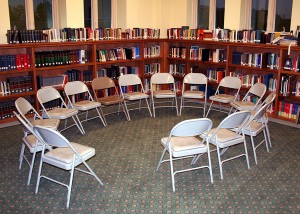2018 School Spending Survey Report
Large Print & Community Building
In the previous article, we explored four libraries’ techniques for acquiring, curating, and promoting their large print collections. We also asked each librarian or manager to talk about how they use the collections in their community programs and outreach efforts. What we found was encouraging.
Using a library’s large print collection to help those with reading challenges, and to serve the local community.
By John Parsons In the previous article, we explored four libraries’ techniques for acquiring, curating, and promoting their large print collections. We also asked each librarian or manager to talk about how they use the collections in their community programs and outreach efforts. What we found was encouraging.
In the previous article, we explored four libraries’ techniques for acquiring, curating, and promoting their large print collections. We also asked each librarian or manager to talk about how they use the collections in their community programs and outreach efforts. What we found was encouraging. Large Print Demographics
To understand these programs better, one must understand the characteristics of the large print book reader. According to Cuyahoga Library’s Wendy Bartlett, about 75% are seniors. But what constitutes “seniors” is changing. The term used to describe people over age 65 or 70, but that number has moved down to the 50s more recently, Bartlett said. This is due in part to vision changes happening in middle age, but more importantly it reflects the improved selection in many large print collections. The stigma of reading a large print book is also less acute, she noted. Another component of the large print audience (about 10%, Bartlett estimates) are “hyper fans” of a particular author or series. These are people who will check out any copy of the popular book, regardless of the format. The remainder are a mix of ages, including individuals with reading impairments. However, large print is not the only solution for learning or visually impaired individuals. Most of the libraries we contacted have a variety of solutions, including access to braille, audiobooks, text-to-speech, and similar resources. “For the most part, large print is not a major driving force for the visually impaired,” Bartlett said.But What About E-Books?
In talking about outreach programs, and readability in general, the topic of e-books came up quite often. However, most of those we interviewed felt that large print was a far better fit, despite the fact that type size is adjustable on most e-readers. This preference is due only partially to seniors’ purported aversion to technology and preference for the tactile experience of a printed book. In fact, some felt that seniors were becoming more comfortable with technology all the time. The actual barriers have more to do with difficult e-book pricing models (for libraries), and economic barriers affecting patrons. “Libraries serve both affluent and less affluent communities,” Bartlett said. “Not everyone can afford home-based Wi-Fi, or e-book readers. Large print books are available to anyone.”Book Discussion Groups
A mainstay of many libraries is the book group—a perfect opportunity to promote community and common interests through the shared experience of a good book. All those we interviewed cited the availability of large print editions is a key component to a good book discussion. Portland Library’s Lisa Marie Joyce cited multiple examples of on-site and off-site groups, where members of all ages could relate to the same book. The availability of a large print version means that an older or vision-impaired potential member would not feel excluded, and would be empowered to join the discussion. In one poignant example, Joyce recalled a centenarian and her great-niece who began reading the same books, in different formats, resulting in remarkably better connection and conversation. When she (the 105-year-old) passed away, the great-niece started a discussion group, based on “a book recommended by Aunt Ruth.”Senior Outreach
Perhaps the most significant programs using large print books are those that reach patrons who cannot easily visit the library facility. Several we interviewed provide large print collections, on loan to nursing homes and assisted living facilities. These “rotating collections” are refreshed periodically, and provide users with the same opportunity to give feedback and request specific titles. Hickory Library’s Tamara Faulkner, LJ's 2015 Paralibrarian of the Year, describe another such program in detail. The “Seniors Morning Out” events are held in local churches and other non-library facilities throughout the city. Book discussions are only part of the program, but sometimes books are included as an adjunct to a speaker or art project for that day. Faulkner, like many library professionals, is limited by budgets and available time. But she envisions many other opportunities—including outreach to the homeless—where books of all kinds, including large print, will play a part. Programs benefiting from a good large print collection are, apparently, limited only by one’s imagination.RELATED
RECOMMENDED
TECHNOLOGY
ALREADY A SUBSCRIBER? LOG IN
We are currently offering this content for free. Sign up now to activate your personal profile, where you can save articles for future viewing









Add Comment :-
Comment Policy:
Comment should not be empty !!!
kathleen
The 'what about ebooks section' is not included in the above article. It's a duplication of the 'book club' section.Posted : Mar 23, 2016 12:18